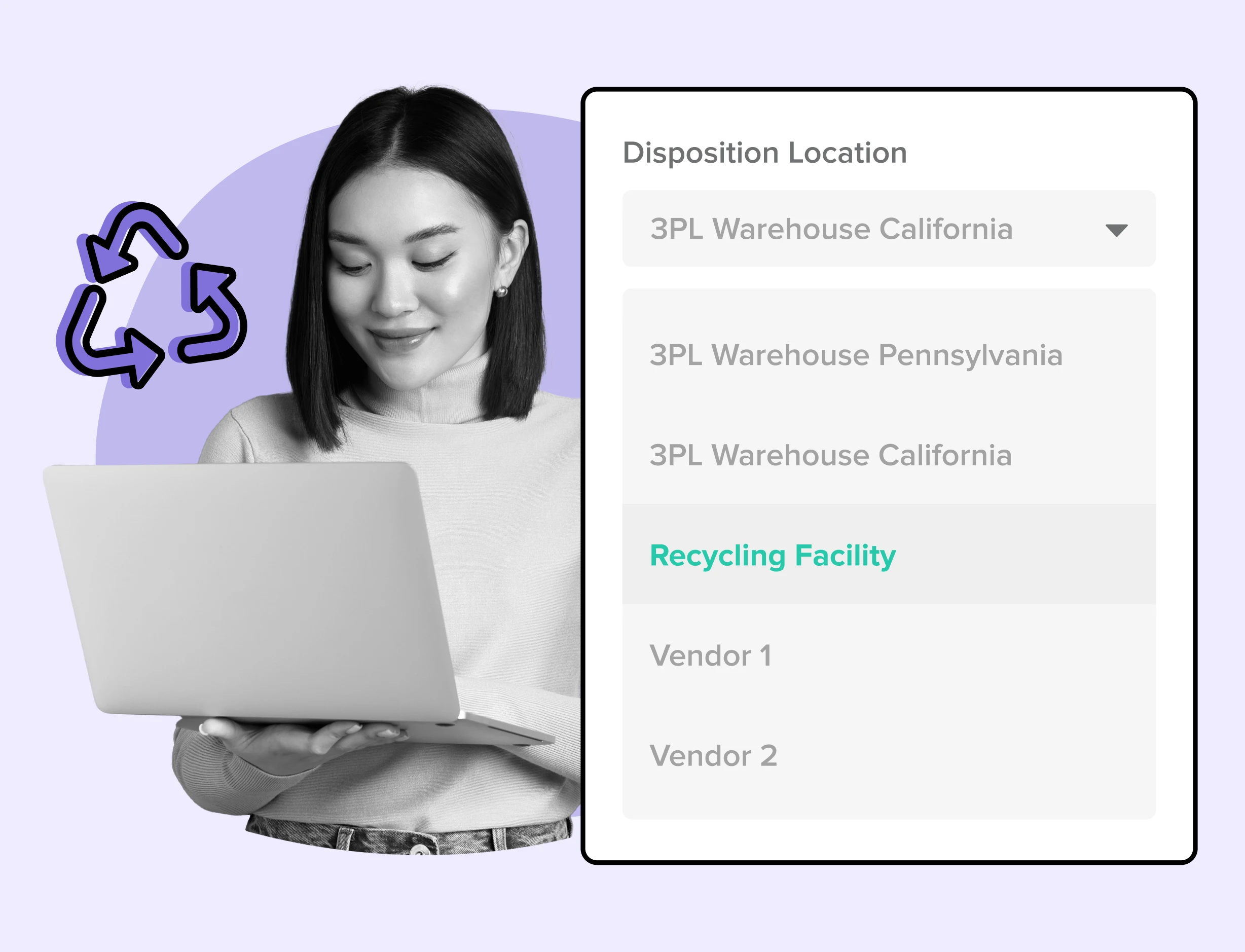
Strategies to Increase Average Order Value with Returns
You can boost AOV: practical strategies like exchanges, store credit, and technology used to transform returns into profit opportunities.
Shipping, Tracking & Notifications
Boost customer experience and reduce support tickets
Realtime order and shipment tracking
Proactive order and shipping notifications
AI-Enhanced Discounted Labels
Predictive pre-purchase estimated delivery dates
Self-Serivce branded order tracking
Effortless experience delivered
Identify and Resolve Order Issues
Realtime order and shipment tracking
Make returns profitable and delight customers
Flexibility to define any return destinations & conditions
Simplify returns for your customers and team
Incentivize exchanges over returns
Returns management made easy for your team
Returns management made easy for your team
Easy claims and smart upsells
Understand why your customers are returning
In-Store & Curbside Pickup
Unify the online and the in-store experience
Hassle-free pickup experience for customers
In-Store dashboard to keep operations streamlined
In-Store and Online orders unified
Drive foot-traffic to your stores
Shipping, Tracking & Notifications
Boost customer experience and reduce support tickets
Realtime order and shipment tracking
Proactive order and shipping notifications
AI-Enhanced Discounted Labels
Predictive pre-purchase estimated delivery dates
Self-Serivce branded order tracking
Effortless experience delivered
Identify and Resolve Order Issues
Realtime order and shipment tracking
Make returns profitable and delight customers
Flexibility to define any return destinations & conditions
Simplify returns for your customers and team
Incentivize exchanges over returns
Returns management made easy for your team
Returns management made easy for your team
Understand why your customers are returning
In-Store & Curbside Pickup
Unify the online and the in-store experience
Hassle-free pickup experience for customers
In-Store Dashboard to keep operations streamlined
In-Store and Online orders unified
Drive foot-traffic to your stores
Boost customer experience and reduce support tickets
Realtime order and shipment tracking
Proactive order and shipping notifications
AI-Enhanced Discounted Labels
Predictive pre-purchase estimated delivery dates
Self-Serivce branded order tracking
Effortless experience delivered
Make returns profitable and delight customers
Flexibility to define any return destinations & conditions
Simplify returns for your customers and team
Incentivize exchanges over returns
Returns management made easy for your team
Equip your team for precise return checks.
Easy claims and smart upsells
Understand why your customers are returning
Unify the online and the in-store experience
Hassle-free pickup experience for customers
In-Store Dashboard to keep operations streamlined
In-Store and Online orders unified
Drive foot-traffic to your stores
Find the answer to all your questions
Take a step by step trip through our functionality to see how we can improve your ecommerce processes.
Explore the most comon questions about WeSupply
Calculate the ROI that WeSupply can bring you
Read actionable articles on how to optimize your post-purchase experience and decrease support tickets
Get inspired by stories of how our customers implemented an effortless post-purchase experience
Wondering if WeSupply is a good fit for you? Read through our use cases to see how we can help you increase conversion & improve CX!
A Deep Dive into Top Companies' Order Tracking & Returns Strategy
Find the answer to all your questions
Explore the most comon questions about WeSupply
Calculate the ROI that WeSupply can bring you
Request a no strings attached review of your current shopping experience and missed conversion opportunities
Take a step by step trip through our functionality to see how we can improve your ecommerce processes.
Read actionable articles on how to optimize your post-purchase experience and decrease support tickets
Get inspired by stories of how our customers implemented an effortless post-purchase experience
A Deep Dive into Top Companies' Order Tracking & Returns Strategy
Wondering if WeSupply is a good fit for you? Read through our use cases to see how we can help you increase conversion & improve CX!

The environmental impact of ecommerce returns significantly burdens the environment, mainly due to the extra shipping, packaging, and processing involved. With online return rates as high as 30%, these processes increase carbon emissions and waste. This article delves into the environmental costs tied to the environmental impact of ecommerce returns and examines potential ways to mitigate these impacts.
Ecommerce returns contribute significantly to environmental issues, generating around 24 million metric tons of CO2 emissions annually and producing substantial packaging waste, often ending up in landfills.
The fashion industry faces the highest return rates, with up to 40% of online garment purchases being sent back, which significantly exacerbates carbon emissions and waste due to the energy-intensive processes involved in handling returns.
Both consumers and retailers need to adopt more sustainable practices, such as accurate product descriptions to reduce returns, implementing reverse logistics solutions, and using sustainable packaging, to mitigate the environmental impact of ecommerce returns.
WeSupply reduces the environmental impact of eCommerce returns with automatic labels, printerless QR code returns, and in-store options. Intelligent Dispositions, Green Returns, and Return Analytics optimize processes. Features like instant credit and self-service returns enhance efficiency and customer satisfaction. Get started with WeSupply today!
Online shopping often brings to mind its convenience and variety. However, a darker side to this convenience is frequently overlooked. On average, customers return up to 30% of products bought online, a rate significantly higher than that of in-store purchases. This high return rate places a substantial strain on the environment, contributing to approximately 24 million metric tons of CO2 emissions annually. The extent to which online purchases varies from in-store purchases in terms of return rates is a crucial factor to consider for both consumers and retailers.
The environmental impact of returns is not limited to carbon emissions. The process of handling returns involves additional shipping, packaging, and processing, all of which consume energy and resources. These hidden costs add up, making ecommerce returns a significant environmental issue that demands our attention and action.
With the surge of online shopping, there has been a corresponding increase in returns. In fact, online purchases result in nearly triple the return rate of in-store purchases. This spike in returns leads to substantially more emissions and waste, exacerbating the environmental impact of the ecommerce industry. The fashion industry, in particular, sees the highest return rates, with customers sending back up to 40% of garments.
Clothing returns alone release emissions equivalent to those of 3 million cars annually in the United States. The process of handling these returns often involves cleaning, re-packaging, or repairing items, which further increases energy consumption. Moreover, returned items are sometimes sent directly to landfills, adding to pollution and environmental damage.
The issue of packaging waste is equally alarming. Up to 91% of plastic packaging waste from online returns ends up in landfills or polluting the environment. This excessive use of plastic and other packaging materials contributes to a huge environmental footprint, highlighting the need for more sustainable practices in the ecommerce returns process.
WeSupply helps merchants reduce environmental impact and build customer trust by promoting eco-friendly returns, streamlining return processes, enhancing product information, offering digital return labels, and supporting recycling programs.
Discover your potential savings and contribute to a sustainable future with our ROI Calculator.
The environmental costs of ecommerce returns are multifaceted, encompassing carbon emissions, waste, and resource consumption. The extra shipping and packaging required for returns significantly affect the environment. The fashion industry, with its high return rates, exemplifies the scale of the problem, as customers send back up to 40% of garments.
With almost triple the return rate of physical store purchases, online shopping contributes to up to 24 million metric tons of CO2 emissions annually. This substantial environmental footprint underscores the need for more efficient and sustainable return processes.
The carbon footprint of online returns is increasing at a worrying pace, contributing up to 24 million metric tons of CO2 emissions annually. These emissions typically add up to 30% more than the emissions from the initial delivery. The shipping of returned items back and forth generates significant greenhouse gas emissions, further exacerbating the environmental impact.
The fashion industry, responsible for 10% of global carbon emissions, plays a significant role in this issue. Returned goods are estimated to produce 27 million tonnes of carbon dioxide emissions annually. Adding to the problem, only 54% of all packaging used for returns is recycled, with the rest contributing to landfill waste.
Nearly EUR 6 billion worth of returned goods end up in landfills each year. This massive waste highlights the inefficiencies in the current return processes and the urgent need to address the growing carbon footprint of online returns.
WeSupply can significantly reduce the growing carbon footprint of online returns by streamlining and simplifying the return process. By leveraging WeSupply’s innovative solutions, companies can enhance their return operations while minimizing environmental impact. Key features include:
Printerless Returns via QR Code: Enhances customer experience by allowing returns without the need for a printer. Customers receive a QR code instead of a PDF and can drop off returns at eligible FedEx Office, Walgreens, and United States Post Office locations, reducing paper waste and improving convenience.
Return In-Store or via Curbside: Emulates the convenience of drive-through services for returns, a practice adopted by major retailers like Target, Walmart, Nordstrom, and DSW, thereby reducing the carbon footprint associated with shipping returns.
Fast fashion significantly contributes to emissions and waste. The emissions released from clothing returns are equivalent to those of 3 million cars annually in the US. The trend of discarding returns is particularly prominent in the fashion industry, with an average return rate of 32% for clothing.
The fashion industry is responsible for:
around 10% of global carbon emissions, more than all international flights and maritime shipping combined
85% of all textiles going to dumps each year, contributing significantly to waste
the dyeing and finishing processes in the fashion industry being the largest drivers of the industry’s global pollution impacts, accounting for 36%.
Synthetic fibres like polyester, nylon, and acrylic used in fast fashion take hundreds of years to biodegrade. The production of polyester, a common fabric in fast fashion, is an energy-intensive process that requires large amounts of petroleum. These factors highlight the substantial environmental impact of the fast fashion industry and the need for more sustainable practices.
Significant carbon emissions are generated by the return shipping processes. In fact, returns from international shipping contribute to 3% of the world’s total carbon emissions. Returns processing can take up to three times the initial delivery time. This can lead to an increase in emissions.
Returns are known to contribute 30% more carbon emissions compared to the initial delivery, making them an important factor in environmental impact. This highlights the significance of optimizing return processes to reduce their environmental footprint. This inefficiency highlights the environmental cost of return shipping. Moreover, ecommerce returns contribute up to 24 million metric tons of CO2 emissions annually, significantly influencing global carbon footprints.
International shipping, often involved in return processes, accounts for around 3% of the world’s total carbon emissions. This substantial contribution underscores the need for more efficient and sustainable return shipping practices.
Ecommerce returns entail complex, resource-intensive logistics. The process frequently involves additional shipping and packaging, leading to increased emissions and waste. Many retail warehouses are located overseas, meaning returned parcels often travel internationally, significantly impacting the environment.
Customers return up to 30% of products bought online, adding a considerable strain on the environment. Returns can contribute significantly to carbon emissions, sometimes adding up to 30% of the initial delivery emissions. This impact underscores the importance of managing and reducing returns in the supply chain. These logistics highlight the need for more efficient return processes to reduce environmental impact.
While reverse logistics is essential in managing returns, it brings with it environmental costs. The process often necessitates cleaning, re-packaging, or repairing of products, which amplifies energy consumption. Returns processing may significantly increase emissions due to taking up to three times the initial delivery time. This can contribute to environmental impact.
Despite these costs, reverse logistics can significantly reduce waste by reabsorbing goods back into the supply chain, preventing them from being disposed of and accumulating in the environment. It also enhances recycling by allowing materials from end-of-life products, like electronics and batteries, to be efficiently recycled and reintroduced into manufacturing processes.
By extending the lifespan of products through repair and reabsorption, reverse logistics reduces the need for new production cycles, thereby lowering associated environmental costs. It helps conserve natural resources by minimizing reliance on virgin resources through the efficient recycling of materials.
WeSupply can help businesses understand and manage the energy and emissions involved in reverse logistics by providing intelligent solutions that optimize the handling of product returns. Through advanced technologies, WeSupply enables companies to minimize their environmental impact and streamline their reverse logistics processes. Key features include:
International shipping significantly contributes to return emissions, constituting a considerable portion of overall carbon emissions. In 2022, it accounted for 3% of the world’s total carbon emissions. Many retail warehouses are located overseas, meaning return parcels often travel internationally, contributing to significant environmental strain.
The shipping and returning of products accounted for 37% of total greenhouse gas emissions in 2020. By 2030, the number of delivery vehicles is projected to increase by 36%, leading to an additional 6 million tonnes of CO2 emissions. This highlights the need for more efficient and sustainable international shipping practices.
WeSupply can help businesses reduce return emissions associated with international shipping by offering configurable and region-specific return management solutions. By preventing unnecessary returns, companies can significantly lower their carbon footprint and streamline their return processes. Key features include:
Let your customer handle returns shipping cost with their preferred vendor: Empowers customers to manage their own return shipping, reducing the company’s logistical burden.
Block returns for specific countries: Prevents returns from regions with high return emissions, optimizing overall return management.
Personalize the return experience for each country: Customizes return policies and processes to align with country-specific regulations and customer expectations, minimizing the need for international shipping of returns.
By leveraging WeSupply’s innovative solutions, businesses can significantly reduce the environmental impact of returns, streamline their reverse logistics, and provide a seamless return experience for customers. Ready to transform your return processes and contribute to a greener planet? Book a demo today and see how WeSupply can make a difference.
Create custom return policies
here are many moving pieces in ecommerce logistics. Book a quick call with our experts to see how WeSupply can help you take control by creating custom policies to handle them all easily. You get to decide how you want to handle final sale items, return window lengths, return request approvals, and more.
In ecommerce returns, packaging waste poses a significant environmental concern. Compared to in-person shopping, online shopping returns generate nearly five times more packaging waste. Returned e-commerce products often require additional plastic and cardboard, contributing to packaging waste.
Online shopping, also known as e-commerce, results in about 4.8 times more packaging waste compared to traditional brick-and-mortar stores. This disparity in waste production highlights the environmental impact of online retail. This excessive packaging waste underscores the need for more sustainable packaging solutions in the ecommerce industry, as online shopping leads to a significant increase in waste generation.
A significant environmental challenge of ecommerce is the substantial amount of packaging waste it produces, including materials like cardboard boxes and plastic wrap. E-commerce platforms sometimes instruct customers to use extra materials like bubble wrap if the original packaging is damaged. This leads to an increase in packaging waste, exacerbating the environmental footprint of online shopping.
The United Nations reports that over 8 million metric tons of plastic waste enter oceans annually, equivalent to dumping a garbage truck full of plastic every minute. Consumers are increasingly looking for online retailers that prioritize eco-friendly packaging solutions to reduce waste. Retailers like Loop offer products in reusable, durable containers that can be returned, cleaned, and refilled to eliminate single-use packaging waste.
Amazon’s ‘Ship in Own Container’ initiative encourages vendors to optimize packaging to reduce the need for oversized boxes and filler materials. These efforts highlight the potential for reducing the environmental impact of ecommerce returns by addressing the issue of excess packaging.
The lifecycle of packaging waste in ecommerce is a journey from warehouse to landfill. Returned products generate more plastic packaging waste during unwrapping, processing, and repackaging stages. Unfortunately, 91% of packaging waste from returned products ends up in landfills or polluting the environment.
Plastics are manufactured from natural resources like crude oil, natural gas, and coal. Recycling one pound of polyethylene conserves up to 12,000 BTUs of heat energy, according to the EPA. However, plastic manufacturing emits greenhouse gases, contributing significantly to global warming.
Each year, 8 million tons of plastic are dumped into the ocean, threatening wildlife and ecosystems. This emphasizes the need for effective recycling programs and sustainable packaging solutions to mitigate the environmental impact of packaging waste.
The disposal of returned products in landfills presents a major environmental issue. In 2022, retailers directly sent over 9.5 billion pounds of returned products to landfills as it’s typically more cost-efficient. This practice contributes to landfill overflow and environmental degradation.
The long-term impact of synthetic materials in these returned products is particularly alarming. Synthetic materials like polyester can remain in landfills for decades, releasing plastic particles and polluting the environment. This underscores the need for more sustainable practices in managing returns.
Synthetic materials pose a significant environmental threat due to their long-lasting presence in landfills. Synthetic fibers like polyester, nylon, and acrylic are non-biodegradable and can persist in the environment for hundreds of years, contributing to landfill waste. The production of synthetic fibers demands significant energy, primarily from fossil fuels, leading to substantial greenhouse gas emissions.
Some of the environmental impacts of synthetic materials include:
Long-lasting presence in landfills
Non-biodegradability
Contribution to landfill waste
High energy demand for production
Greenhouse gas emissions
These factors highlight the need for more sustainable materials as alternatives to synthetic materials.
Microplastics released from washing synthetic textiles can pollute water bodies, endangering marine life and potentially entering the food chain. The production of synthetic fibers also consumes large amounts of water for cooling and processing, exacerbating freshwater scarcity in some regions. These factors highlight the huge environmental impact of synthetic materials and the need for more sustainable alternatives.
Returned items often end up in open-air dumping sites. For example, Chile’s Atacama Desert has become a significant dumping ground for unwanted clothing. Returned products, even if in brand new condition, can often end up in liquidation warehouses.
Following the 2020 holiday season, it was estimated that over $70 billion worth of online purchases would be returned. Big retailers sometimes find it economically unfeasible to resell returned products, leading them to liquidation warehouses where they are:
sorted and categorized
inspected for any damages
repackaged if necessary
sold to resellers
Approximately 25% of all returned products get destroyed, sometimes ending up in landfills or being burned.
WeSupply can help prevent products from ending up in landfills by offering innovative Green Returns solutions that encourage sustainable practices. By allowing customers to keep low-cost items when requesting a return, companies can save on return shipping costs and reduce waste. This approach not only benefits the environment but also enhances customer satisfaction. Key features include:
Issue refunds faster: Improves customer experience by providing quick refunds or exchanges.
Increase customer satisfaction: Enhances the return process, making it more convenient and environmentally friendly for customers.
The management of returned items is significantly influenced by economic and regulatory factors. In fact, less than 48% of all returned items can be re-sold at full price. Economic incentives and cost structures significantly drive the decision-making process regarding the handling of returned items in ecommerce.
Governments around the world vary greatly in their regulatory frameworks concerning the disposal and management of returned goods, affecting how companies handle these returns. This lack of regulation allows companies to dispose of returns in landfills without facing significant legal repercussions.
For many companies, the cost of re-selling returned items often exceeds the cost of discarding or incinerating them. Renowned brands like H&M and Burberry have acknowledged burning returned products worth millions of dollars annually to uphold their brand value. The process of inspecting and repackaging returned items often exceeds the item’s resale value, making it more economical for retailers to discard them.
Returned goods rarely make it back into the original inventory due to the costs and logistics involved in refurbishing and reselling. Retailers often discard returned items because:
The cost of processing and reselling them can be higher than simply throwing them away
The items may be damaged or no longer in sellable condition
The items may be outdated or no longer in demand
This highlights the economic realities that drive the disposal of returns.
Items requiring extensive cleaning or other processing steps may be discarded because the costs are not justified. Some retailers trash returns to avoid products ending up in secondary markets, which can tarnish the brand’s value. Luxury brands are more likely to discard returns to avoid devaluing their products on secondary markets.
Due to insufficient regulations, items that cannot be resold frequently end up in landfills. In many regions, weak regulations allow companies to dispose of returns in landfills without facing significant legal repercussions. Companies frequently take advantage of regulatory loopholes to avoid the costs associated with environmentally friendly disposal practices.
The fashion industry faces virtually no regulation, allowing companies to have a competitive edge by disregarding environmental and social impacts. Public pressure can sometimes force companies to adopt temporary ‘environmental sustainability’ policies without long-term commitments. This underscores the need for stricter regulations and binding commitments to ensure sustainable practices in managing returns.
Each industry faces its own unique set of challenges and environmental repercussions associated with returns. E-commerce sales have a return rate of 30%, significantly higher than the less than 9% for brick-and-mortar stores. The fashion industry recorded the highest return rates, with up to 40% of garments being sent back by customers.
The consumer electronics industry also faces significant return issues, with returned electronics contributing to electronic waste and complex disposal processes due to hazardous materials. These industry-specific insights highlight the need for tailored strategies to address the environmental impact of returns.
The fashion industry, known for offering free returns, has the highest return rates, with customers returning up to 40% of garments bought online. Clothing returns release the same emissions as 3 million cars in the US. Fast fashion and commercial holidays like Black Friday have exacerbated the return rates in the fashion industry.
Many returned garments are created with synthetic materials like polyester, which emit plastic particles and pollute the environment when discarded. Practices like ‘bracketing’ and ‘wardrobing’ exacerbate the volume of clothing returns, adding unnecessary emissions. Some 43% of young consumers intend to continue wardrobing, where they buy and wear an item once before returning it.
Up to 9.5 billion pounds of returned products were sent to landfills in 2022, with fashion items contributing significantly. This highlights the need for more sustainable practices in the fashion industry’s return processes.
The return rate for consumer electronics stands at around 7%. Returned electronics contribute to electronic waste, which involves complex disposal and recycling processes due to hazardous materials.
Returned consumer electronics often require cleaning, re-packaging, or repair, increasing the environmental impact. The transportation involved in returning consumer electronics adds up to 30% more carbon emissions compared to the initial delivery. These factors highlight the need for more sustainable practices in managing returns in the consumer electronics industry.
The environmental impact of returns is significantly influenced by consumer behaviors. Environmental awareness among consumers is increasing, leading them to prefer sustainable products and services. However, there exists an ‘attitude–behavior gap’ where consumers’ positive environmental attitudes do not always translate into purchasing green products.
Factors such as Environmental Attitude and Environmental Oriented Lifestyle significantly affect Environmental Purchasing Behavior. Customers return up to 30% of products bought online, significantly contributing to environmental strain. This highlights the need for consumers to adopt more responsible shopping habits to reduce the environmental impact of returns.
Bracketing, where consumers order multiple sizes or colors of the same item to keep only one, leads to a significant increase in return rates. The practice of bracketing contributes to higher carbon emissions due to increased shipping and handling of returned goods.
In 2020, two-thirds of customers purchased items in multiple sizes and colors with the intention of returning many of them. This purchasing behavior reflects the growing trend of online shopping and the need to try items at home before making a final decision. This practice involves extra packaging materials, contributing to increased waste and environmental impact. Returning products increases the time and fuel required for transport, contributing significantly to climate change.
WeSupply helps prevent the environmental toll of bracketing—the practice of buying multiple sizes or versions of a product with the intention of returning most of them—by offering eco-friendly return solutions and advanced analytics. By implementing printerless returns and Intelligent Dispositions, WeSupply ensures a more sustainable return process. Key features include:
Printerless Returns with QR Codes: Reduces paper waste by allowing customers to use QR codes instead of printed return labels.
Intelligent Dispositions: Directs returned items to appropriate locations, such as recycling centers, minimizing their environmental impact.
Return Analytics: Leverages return analytics to address bracketing issues, enhancing both customer satisfaction and business efficiency. By analyzing return data, businesses can identify patterns and root causes of returns, enabling targeted improvements in product offerings and return policies. This data-driven approach helps reduce unnecessary returns and exchanges, optimizing the customer experience and improving profit margins.
These initiatives showcase WeSupply’s dedication to sustainability while simplifying and improving the returns process.
Wardrobing involves purchasing items with the intent to use them temporarily and then return, creating unnecessary environmental waste. According to a survey conducted in 2022, around 43% of 16-24-year-olds expressed their intention to continue wardrobing in the future. This indicates a significant interest in this trend among the younger demographic. This practice leads to increased resource usage and waste generation due to the temporary nature of the purchases.
Wardrobing is a form of return fraud where customers purchase items, use them briefly, and then return them for a full refund. Approximately $22.8 billion worth of returned online purchases are estimated to be fraudulent, including practices like wardrobing. This contributes to significant financial losses for e-commerce businesses due to increased labor costs and inventory management challenges.
The anonymity of online shopping has made it easier for customers to engage in wardrobing without face-to-face interaction. This emphasizes the need for stricter return policies and customer education to deter such practices.
WeSupply offers comprehensive solutions to prevent wardrobing return fraud through its robust suite of return management tools. Key features include:
Blocklist (email address or customer group): Use blocklisting of email addresses or customer groups to prevent fraudulent returns, safeguarding business interests and revenue.
Automated Returns Management: Improves reverse logistics with thorough inspections, streamlined communications, and predefined quality criteria for returns.
Branded Returns Portal: Enhances customer loyalty while identifying suspicious return patterns.
Store Credit: Deters fraudulent activity by encouraging reinvestment in the product catalog.
Digital Monitoring and Returns Analytics: Provides actionable insights and efficient handling of returns to maintain customer satisfaction.
These tools equip businesses with the framework to manage returns effectively and curb fraudulent activities, ensuring a seamless and secure return process.
A multifaceted approach is required to reduce the environmental impact of ecommerce returns. Retailers should evaluate both their forward and reverse supply chains to improve transparency, communication, and accountability. Implementing Buy Online, Pick Up In-Store (BOPIS) can reduce the number of returns shipped back to fulfillment centers.
Using low-emission delivery vehicles and neighborhood-based fulfillment hubs can minimize the environmental impact. Secondary markets like B-Stock, Blinq, and BULQ help retailers resell returned or excess goods, reducing landfill waste. These strategies highlight the potential for reducing the environmental footprint of returns through more efficient and sustainable practices.
Consumers can make a significant difference by adopting conscious shopping habits. Here are some tips to help you make informed purchasing decisions and reduce unnecessary returns:
Read accurate and comprehensive product descriptions
Check sizing guides to ensure the right fit
Pay attention to material details and care instructions
By following these tips, you can shop more consciously and minimize the need for returns.
Planning ahead with comprehensive shopping lists can reduce the number of trips to the store, lowering carbon emissions. Choosing products from brands that prioritize sustainability can encourage broader adoption of eco-friendly practices. Supporting local businesses and opting for high-quality, timeless clothing pieces can minimize waste and boost local economies, making traditional shopping a more environmentally conscious choice.
A conscious consumer actively aligns purchasing decisions with a desire to positively impact the environment and society. They prefer products that are eco-friendly, such as organic items or those using minimal packaging. This shift towards conscious consumerism can drive industries towards more sustainable practices.
Retailers can implement various strategies to optimize returns and reduce waste. Some strategies include:
Developing accurate product content
Using photography to outline product dimensions
Conducting a waste audit to understand waste streams and identify opportunities for waste reduction and diversion.
Embracing sustainable packaging methods like biodegradable bags and reusable packaging can significantly reduce the environmental impact. Implementing the ‘reduce, reuse, recycle’ mantra in retail can minimize waste, for instance, by encouraging customers to use reusable bags. Sustainable sourcing, which involves buying products with minimal environmental impacts, is crucial for waste reduction in retail.
Educating and involving employees in waste reduction initiatives is essential for fostering a culture of sustainability within retail operations. Engaging customers to make environmentally friendly purchasing decisions can significantly influence waste reduction in retail. Donating unsold items to local charities instead of discarding them helps reduce waste and supports community welfare.
WeSupply empowers retailers to optimize returns and reduce waste through a variety of strategic features. Key offerings include:
Self-Service Returns Process: Enables a frictionless return experience, giving shoppers complete control over the return process and saving retailers time.
Flexible Returns Rules: Allows the creation of tailored return policies that match any use case, avoiding restrictive and one-size-fits-all approaches.
Autogenerated QR Code Return Labels: Simplifies the return process by allowing customers to scan a QR code from their email, eliminating the need for printing.
Returns Tracking: Provides customers with the ability to track their return’s progress and check status updates easily.
Buy Online, Return In-Store: Enhances convenience by allowing customers to return online purchases in-store, making the process seamless and efficient.
These features help retailers streamline their return processes, save on costs, and enhance customer satisfaction while promoting sustainable practices. Experience the difference with WeSupply—Book a demo today!
Simplify Returns for Your Customers and Support Team
Book a quick call with our experts to see how WeSupply can help you: simplify the Return experience with just a few clicks, reduce customer service calls and manual processing, notify your customer about their refund, automate returns and reduce user error
Technological and logistical innovations offer promising solutions for reducing the environmental impact of returns. Advanced tracking and tracing systems in reverse logistics provide real-time visibility into the reverse supply chain, improving efficiency and reducing waste. Electronic Return Merchandise Authorization (RMA) systems facilitate customer returns and optimize the process.
Automated sorting and disposition of returns reduce costs associated with storage, transportation, and labor. Technology enables businesses to adopt eco-friendly practices in recycling, reducing waste and environmental impact. These innovations highlight the potential for leveraging technology to create more sustainable return processes in ecommerce.
Virtual try-ons have the potential to significantly reduce return rates by allowing customers to see how products fit before purchasing. Virtual try-on technology uses augmented reality (AR) and virtual reality (VR) to allow consumers to digitally try on items such as:
furniture
makeup
eyewear
accessories
clothes
cars
These technologies enhance accuracy in size and fit, ensuring higher satisfaction with purchases. By reducing the ambiguity around clothing sizes, 3D body scanning helps personalize recommendations and ensure the perfect fit. Retailers integrating these technologies can experience lower return rates due to more accurate sizing.
AR-guided purchases have led to a 25% decrease in returns, addressing the $550 billion problem of returns. Virtual try-ons and 3D body scanning offer consumers the convenience of trying on clothes without leaving home. This highlights the potential for virtual try-ons to reduce the environmental impact of returns.
Reverse logistics partnerships offer sustainable solutions for managing ecommerce returns. Reverse logistics involves:
Returning
Recycling
Refurbishing
Disposing of products sustainably and efficiently
Advanced algorithms can predict customer behavior, offering preventive measures to encourage customers to keep products, ultimately leading to a positive customer experience.
A robust reverse logistics strategy is crucial for sustainable business operations due to the high volume of online returns. Integrating reverse logistics with eCommerce platforms and Point of Sale systems helps in making informed disposition decisions. Retailers should partner with specialized reverse logistics service providers to effectively manage post-purchase and returns processes.
This highlights the importance of reverse logistics partnerships in promoting sustainable ecommerce.
To create a more sustainable ecommerce ecosystem, it is essential to reassess the returns process. The environmental impact of returns—from carbon emissions and packaging waste to products ending up in landfills—is significant and demands immediate attention. By understanding these impacts and adopting more sustainable practices, both consumers and retailers can contribute to reducing the environmental footprint of ecommerce.
Collective action is required to address this issue effectively. Consumers need to adopt more responsible shopping habits, and retailers must optimize their return processes and embrace technological innovations. Together, we can pave the way for a more sustainable future in online shopping, ensuring that convenience does not come at the cost of our planet.
In summary, the environmental impact of ecommerce returns is a multifaceted issue that involves carbon emissions, packaging waste, and resource consumption. The logistics of handling returns, particularly in industries like fashion and consumer electronics, add significantly to the environmental footprint. The practices of bracketing and wardrobing further exacerbate this problem.
WeSupply helps eCommerce businesses reduce the environmental impact of returns with innovative solutions. Features include automatic return label generation, printerless returns via QR codes, and in-store or curbside returns. Intelligent Dispositions optimize return routing, while configurable international return policies and Green Returns minimize waste. Return Analytics address bracketing issues, and tools like pre-built return policies and automated management prevent fraud. Additional features like instant credit, self-service returns, flexible rules, QR code labels, returns tracking, and buy online, return in-store options enhance efficiency and customer satisfaction. Get started with WeSupply today!
Ecommerce returns have a high environmental impact due to contributing to carbon emissions, packaging waste, and resource consumption through extra shipping, handling, and disposal processes.
Fast fashion returns have a significant environmental impact, releasing carbon emissions and contributing to landfill waste due to high return rates and non-biodegradable materials. It’s important to consider the environmental consequences before making returns.
WeSupply streamlines the return process with automatic return label generation, printerless returns via QR codes, and in-store or curbside return options, minimizing the carbon footprint associated with shipping returns.
WeSupply provides Intelligent Dispositions to dynamically route returned items to the nearest suitable locations, such as warehouses, recycling centers, donation facilities, or outlet stores, reducing unnecessary transportation and emissions.
WeSupply’s Green Returns allow customers to keep low-cost items when requesting a return, saving on return shipping costs and reducing waste. This improves customer satisfaction by providing quick refunds or exchanges and enhancing the return process.
Yes, WeSupply does have an official Shopify App. You can download and begin to integrate it with your Shopify store.
Yes, WeSupply has an official extension for Magento. The WeSupply x Magento integration allows for automating order tracking experiences, reducing customer inquiries, automating shipping email and SMS notifications, and providing a fully branded order tracking experience
Yes, WeSupply has an official BigCommerce App. You can integrate WeSupply with your BigCommerce store to improve your post-purchase customer experience.

Learn How To Create Successful Post Purchase Email Campaigns
Build an effective post-purchase email flow that helps you increase customer satisfaction and drive revenue growth!

You can boost AOV: practical strategies like exchanges, store credit, and technology used to transform returns into profit opportunities.

Turn your returns process into a strategic advantage: make it efficient, create positive customer experiences, use returns data effectively!

Explore practical strategies for reducing return rates, streamlining the returns process, and enhancing your overall customer experience!

By focusing on the 20% of issues causing 80% of your returns, you can implement targeted strategies for major improvements!

How to transform returns data into a powerful tool for refining your product descriptions and improving your bottom line!

Let’s discuss practical strategies businesses can implement to manage the significant environmental impact of eCommerce returns!

Ler’s explore strategies like carbon offsetting, bulk shipping, and returnless refunds to achieve sustainable performance!

This article will show you how to optimize the sales and return process for swimwear, boosting customer satisfaction and revenue!

Practical strategies to optimize returns and exchanges for online furniture stores, helping reduce costs and improve customer satisfaction.